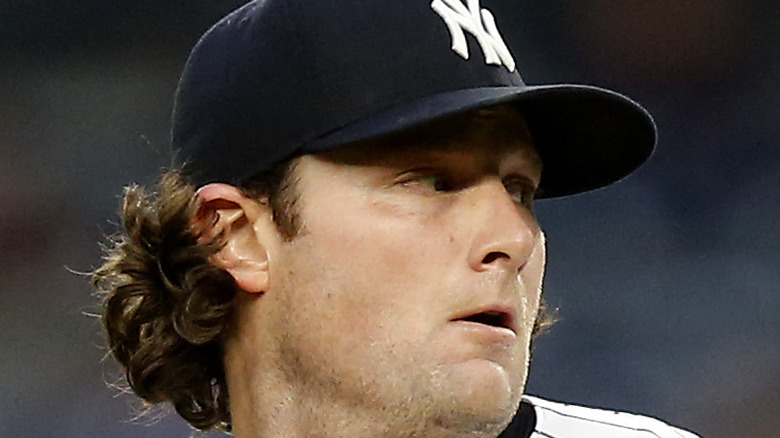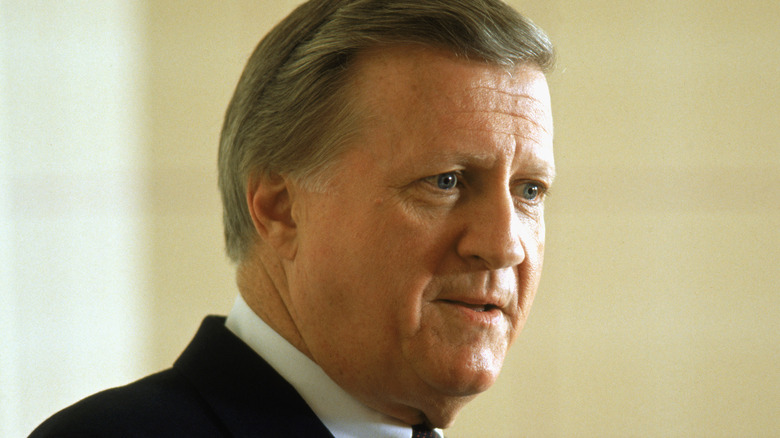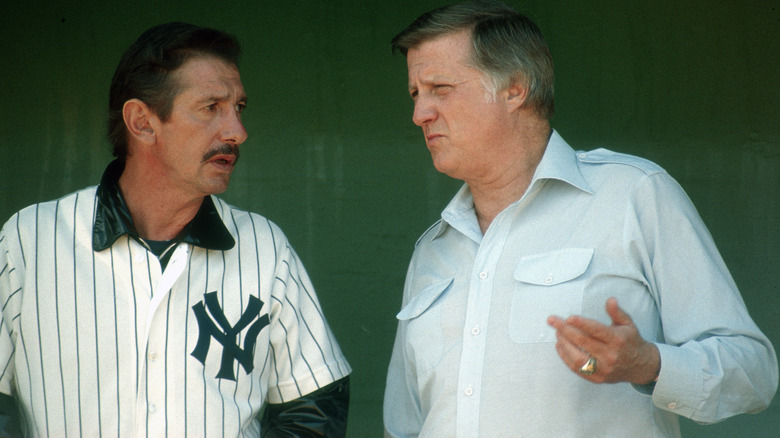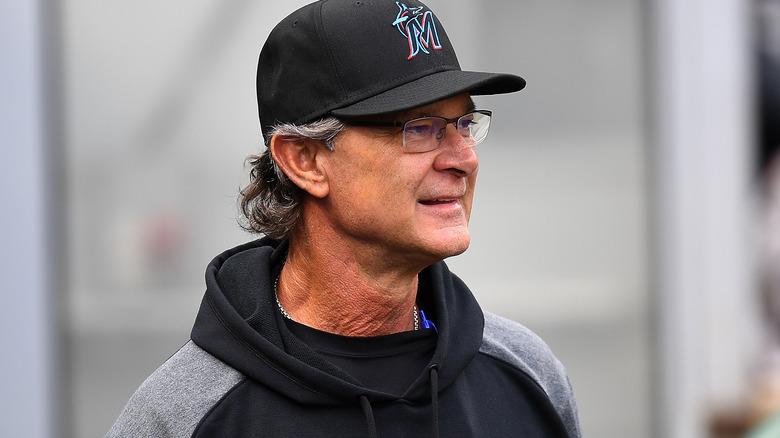The Origin Of The New York Yankees' Bizarre Ban On Beards And Long Hair
The New York Yankees are a Major League Baseball franchise with a long and proud history. From Babe Ruth, Lou Gehrig, Joe DiMaggio, and Mickey Mantle in the olden days to Derek Jeter and Alex Rodriguez in more recent years, the Yankees' rosters have often been chock-full of generational talents. That, of course, has led to a lot of postseason glory — to be specific, 40 American League pennants and 27 championships since their MLB debut at the turn of the 20th century (via Britannica).
Aside from the obvious facts that they've won a plethora of World Series and had some of the most iconic (and often controversial) players of all time wear their pinstripes, there are some things about the Yankees that may not be obvious to the casual fan. For example, if you pause for a minute and compare how pitcher Gerrit Cole looks nowadays as a Yankee to how he looked with the Houston Astros, you will definitely notice that he's been clean-shaven since he took his talents to the Big Apple. His hair, while still slightly on the long side, also appears a bit shorter. That's because, for close to five decades, the Yankees have had a strict policy that prohibits players from sporting beards and wearing their hair long. But how did it originate in the first place?
George Steinbrenner's military experience inspired his decision to ban beards and long hair
James Harden wouldn't have lasted a day with the New York Yankees if he was a Major League Baseball player and not one of the NBA's most talented guards. Ditto the NFL's Aaron Rodgers and Trevor Lawrence, and just about any other athlete known for their distinctive beard, long-flowing locks, or both. (Keeping things closer to home, how about Justin Turner or Noah Syndergaard?) Yes, it's true that the Yankees are very strict when it comes to ensuring their players sport that clean and wholesome look. That policy dates back to the early 1970s when George Steinbrenner became the team's owner.
Back in 1973, it wasn't uncommon for baseball players (or young adult males, in general) to sport some sort of facial hair or shaggy 'do. Enter Steinbrenner, who came up with the idea for the appearance policy after he noticed the long hairdos worn by many of his players made it hard for him to see their numbers on the back of their jerseys. As explained by Inside Hook, the Yankees owner then drew inspiration from his time in the Air Force — and its own policies requiring a clean-cut, short-haired look — and stipulated that "All players, coaches and male executives are forbidden to display any facial hair other than mustaches (except for religious reasons), and scalp hair may not be grown below the collar. Long sideburns and 'mutton chops' are not specifically banned."
The TL;DR version was simple — beards were a no-no for the Yankees from that point forward, and so were hairdos befitting of your average rock musician or roadie.
Steinbrenner wanted to instill discipline
In a 1976 interview with The New York Times, George Steinbrenner said that he instituted the appearance policy because he wanted the New York Yankees to be disciplined. "I have nothing against long hair per se," he explained. "But I'm trying to instill certain sense of order and discipline in the ball club because I think discipline is important in an athlete." The executive also clarified that his players were free to crack wise about the policy, just as long as they played along at the end of the day — failure to get with the program, he stressed, meant that the Yankees would "try to find a way to accommodate them somewhere else." In other words, shape up or ship out.
According to Dan Epstein's book "Stars and Strikes: Baseball and America in the Bicentennial Summer of '76," that was the year in which the Yankees made the appearance policy 100% official. And while Steinbrenner and manager Billy Martin were frequently at odds with each other, with the former hiring, firing, and rehiring the latter so often that it became a running joke, they did see eye-to-eye with regard to the anti-long hair/anti-beard edict. "When we're together, I want them to be Yankees," Martin told The Miami News. "I want them to look like Yankees and dress like Yankees. Beards and long hair aren't the New York Yankees."
The policy remains firmly in place and has an interesting legacy
George Steinbrenner's death in 2010 did not mark the end of the New York Yankees' edict against beards and long hair. According to the official MLB website, the late exec's daughter Jennifer Steinbrenner-Swindal has made it a point to keep enforcing the policy, making sure that today's Yankees maintain an appearance that her father would have approved of. That's precisely the reason why Gerrit Cole, who was known for his long-ish hair and beard, switched to a clean-shaven look and a shorter (though not exactly short) hairdo after he signed a massive free-agent deal with the Yankees toward the end of 2019.
While Cole joined Randy Johnson, Johnny Damon, and other high-profile acquisitions from recent decades who toed the line and cut their hair and/or shaved their beards upon joining the Yankees, there have, of course, been some notorious offenders. Back in 1991, multiple-time All-Star first baseman Don Mattingly was benched by the Yankees for refusing to chop off his trademark mullet. This incident generated so much controversy that "The Simpsons" parodied it in the Season 3 episode "Homer at the Bat," where Mattingly was one of several MLB stars who voiced themselves as ringers for the Springfield Nuclear Power Plant's softball team.
Ironically, Mattingly himself instituted a facial hair ban in 2016 while managing the Miami Marlins; doubly ironic is the fact that he wore a mustache for most of his MLB career as an active player. But thankfully for those Marlins who preferred a more hirsute look, Mattingly (pictured above, sans 'stache) relaxed the policy just one year later.



